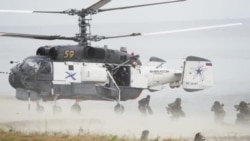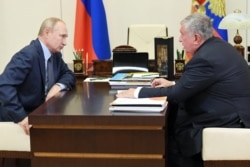In August, Russia announced a joint project with China to produce a “new generation non-atomic submarine.” The project is part of an arms deal Moscow signed earlier this year with Beijing involving weapons deals in “three spheres: water, air, land,” the Russian agency for military and technical cooperation said.
This “unprecedented cooperation” with China gives Russia an advantage over the U.S. Navy, which “projects its might far beyond its territories,” Mikhail Aleksandrov, an expert at the Moscow State Institute of International Relations’ Center for Military Policy Studies, told the state-run Federal New Agency.
Aleksandrov predicted it would be an “unpleasant surprise” for the Americans. “[B]ut the Americans themselves are to blame, as they are bullying Russia and spoiling for a fight,” he added.
The claim of bullying is false; in fact, just the opposite is true. That is clear from recent incidents that are part of an uptick in “near-confrontation” military encounters between the countries.
Alaska fishermen
The latest incident took place on Aug. 28 in the Bering Sea. Alaskan fishermen reported that a group of U.S. fishing trawlers was operating in neutral waters 80 miles from the U.S.-Russia maritime boundary when Russian voices started coming out of their ships’ radios.
The voices switched to English and ordered the fishermen “to move away at maximum speed.” Immediately after the warning, the American fishermen saw that “[t]hree warships and two support vessels of theirs were coming and would not turn,” according to Alaska Public Media. The Russian war vessels “came marching right through” the fishing fleet, a witness said.
A video filmed from one of the American fishing boats and posted on YouTube confirms the account. Other boats were “buzzed” by Russian aircraft, which flew low over the fishing fleet and ordered the Americans to leave the area in a specific direction.
The U.S. said initially that it knew about the Russian naval drills in the Bering Sea and had been observing them, but later added that officials would investigate “unprofessional interactions” by the Russian military.
Russia said more than 50 warships, including two nuclear submarines, and 40 aircraft, including nuclear-capable bombers, took part in the Bering Sea war games dubbed “Ocean Shield.”
The drills included launching P-1000 Vulkan missiles from a cruiser and P-100 anti-ship cruise missiles from a submarine.
The Russian defense ministry released a video of its “Omsk” nuclear-powered cruise missile submarine surfacing “near the coast of Alaska.” One of the country’s top admirals said the exercise was “a signal to NATO.”
According to news reports, during the exercises, the U.S. military eventually moved from “observing” to “intercepting” after six Russian Tu-142 maritime patrol aircraft and Su-35 fighter jets “entered the Alaskan Air Defense Identification Zone” overnight on Aug. 27-28.
This was the fifth such incident off the coast of Alaska this year involving Russian military aircraft, U.S. officials said.
Syria Convoys
On Aug. 27, the Russian defense ministry said in a statement that military police “undertook necessary measures to prevent an incident” in eastern Syria when a U.S. military convoy “attempted to block” a Russian patrol in “violation of existing agreements.”
A few hours earlier, the Pentagon had said several U.S. troops were injured as a result of “deliberately provocative and aggressive behavior" by Russian forces during a collision between the American and the Russian convoys in eastern Syria.
Both statements referred to an incident that took place in Syria’s eastern Hasakah province on Aug. 26. Video of the incident showed up on Rusvesna.su, a Russian website known for publishing videos recorded by the Russian troops and veterans, under the headline: “How the Russian Army pursued U.S. troops in Syria.” The U.S. publication Military Times also published a video of the incident.
In the video, Russians can be heard clearly communicating with other vehicles and aircraft, coordinating their moves. The phrases in Russian include “faster, faster,” “don’t let them escape,” “cut them off,” “block them,” along with some derogatory language.
In a similar incident in Syria, which was also filmed and posted by Rusvesna.su on July 17, a Russian officer scolds his American counterpart through a Russian serviceman who was translating, saying: “Let him tell his general that the Russians have earnestly asked not to pursue them again.”
In February 2018, hundreds of Russian mercenary troops reportedly were killed after U.S. forces came under artillery attack from pro-Syrian government forces. Russian officials disputed that a large number of Russian mercenaries died.
Arctic Oil
On Aug. 18, the head of the Russian oil giant Rosneft, Igor Sechin, visited President Vladimir Putin in his Novo-Ogaryovo residence outside Moscow. Sechin brought Putin a gift: a fancy, framed bottle of Arctic oil. The Russian energy industry under Putin is boosting its presence in the Arctic, with multibillion-dollar investments in oil and natural gas, new transportation hubs and protected sea corridors.
Alaska and the Arctic region are increasingly becoming a site of a great-power strategic competition, and some analysts say the U.S. needs to change its thinking about Alaska. In mid-August, the Trump administration said it would start offering leases for oil and gas development in Alaska’s Arctic National Wildlife Refuge by year’s end.
On Tuesday, Aug. 8, Norway announced that its navy will participate in NATO military drills in the Barents Sea – entering, for the “first time in recent history,” the “Russian exclusive economic zone.”
The U.S. said the drill will be led by the British Navy and is aimed at improving security to protect the freedom of navigation “in the challenging environment above the Arctic Circle.”
On Tuesday, the Russian government newspaper Rossiyskaya Gazeta cited the Russian armed forces’ National Center of Defense Administration as saying that it is monitoring the movements of NATO vessels in the Barents Sea. If there is a confrontation, “American missiles and strategic aviation will hit Russia via the North Pole,” but Russia is ready for that and “the region is under our control,” the report said.







